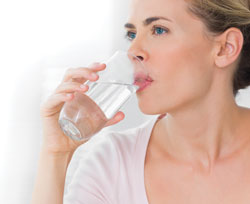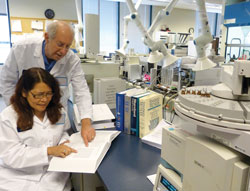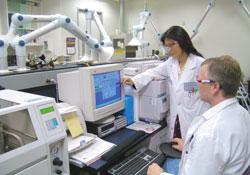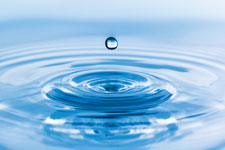Water, Water, Everywhere
FOOD SAFETY & QUALITY
 Water is necessary for life, but it is also necessary for manufacturing foods and beverages, whether as an ingredient or as a processing aid used for cleaning, moving, and other functions. Since the quality of water obtained from a variety of locations and sources may differ, food and beverage processing plants must ensure that the water used in their products meets specifications for quality and safety.
Water is necessary for life, but it is also necessary for manufacturing foods and beverages, whether as an ingredient or as a processing aid used for cleaning, moving, and other functions. Since the quality of water obtained from a variety of locations and sources may differ, food and beverage processing plants must ensure that the water used in their products meets specifications for quality and safety.
Water used as an ingredient in foods and beverages may come from groundwater sources such as wells and spring water or surface water sources such as municipal systems. The water may contain natural minerals as well as various contaminants—physical, chemical, microbial, and radiological—and must be treated before use. Water from municipal treatment systems may contain chlorine and chloramines used to disinfect the water. Consequently, food and beverage manufacturers need to have an effective water quality and safety management strategy in place, generally as part of their Hazard Analysis and Critical Control Points program. The water they use as an ingredient must meet certain regulatory standards.
U.S. Regulations
The U.S. Environmental Protection Agency (EPA) (www.epa.gov) has established standards for public water systems. Under the 1974 Safe Drinking Water Act, the EPA sets maximum contaminant levels (MCLs) for about 90 different contaminants in drinking water, grouped into six categories: microorganisms, disinfectants, disinfection byproducts, inorganic chemicals, organic chemicals, and radionuclides. The MCLs reflect both the level that protects human health and the level that water systems can achieve using the best available technology. The EPA also sets water-testing schedules and analytical methods that must be used. Individual states can set and enforce their own drinking water standards if the standards are at least as strong as the EPA’s standards.
Public water systems must periodically monitor for the presence of specific contaminants, using analytical methods approved by the EPA. The methods are developed by the EPA, other government agencies, universities, consensus methods organizations, water laboratories, and instrument manufacturers. Laboratories that analyze these compliance samples must be certified by the EPA or the state, and the EPA has a certification program to ensure that laboratories are qualified to analyze drinking water samples. Certified laboratories must successfully analyze proficiency testing samples annually and pass periodic onsite audits. The agency’s Laboratory Certification Manual describes the certification program, laboratory procedures, and technical criteria that laboratories must meet. The fifth edition was published in January 2005, and supplements were published in June 2008 and November 2012.
The Federal Food, Drug, and Cosmetic Act (FD&C Act) requires standards for bottled water by the U.S. Food and Drug Administration (FDA) to be at least as stringent as the EPA’s standards for public water systems. The FDA’s January 2013 Guidance for Industry: A Food Labeling Guide says that water added in making a food is considered to be an ingredient and must be included in the ingredients list in descending order of predominance by weight. If all water added during processing is subsequently removed by baking or some other means during processing, it need not be declared as an ingredient.
Kimberly Rawlings, Health Communications Specialist, Strategic Communications and Public Engagement, FDA Office of Food and Veterinary Medicine, said that according to a memorandum of understanding between the EPA and the FDA, drinking water is under the control of the EPA, and water used in food (including bottled water) is under the FDA’s jurisdiction. Specifically, “FDA retains authority over bottled drinking water. … All water used in food remains a food and subject to the provisions of the FD&C Act. Water used for food processing is subject to applicable provisions of the FD&C Act. Moreover, all substances in water used in food are added substances subject to the provisions of the FD&C Act, but no substances added to a public drinking water system before the water enters a food processing establishment will be considered a food additive.”
Rawlings said that according to the agency’s regulation for current good manufacturing practice (GMP) in manufacturing, packing, or holding human food, published in the Code of Federal Regulations (21 CFR 110.37), each plant must be equipped with adequate sanitary facilities and accommodations, including a water supply that is safe and of adequate sanitary quality. For bottled water, there is a standard of quality covering numerous physical, chemical, radiological, and microbiological contaminants and also bottled water-specific GMPs with source-water and product-water testing requirements.
Bottled water companies must meet the FDA’s standard of identity (including labeling requirements), standard of quality, and current GMPs. The bottled water standard of identity (21 CFR 165.110(a)) says that bottled water is water that is intended for human consumption and sealed in bottles or other containers with no added ingredients except that it may contain safe and suitable antimicrobial agents and minerals for taste if identified as such. Fluoride may be optionally added. Bottled water may be used as an ingredient in beverages (e.g., diluted juices, flavored bottled waters).
--- PAGE BREAK ---
The quality standard (21 CFR 165.110(b)) establishes allowable levels of contaminants in bottled water. All bottled drinking water sold in interstate commerce in the United States, including products from other countries, must meet the FDA standards for physical, chemical, microbial, and radiological contaminants. In addition, 21 CFR 165.110(c) says that if bottled water contains a substance at a level greater than that allowed under the quality standard, the label must bear a statement that the product is of substandard quality, such as “contains excessive bromate,” “contains excessive bacteria,” or “excessively radioactive.” Regardless of whether bottled water bears a statement of substandard quality, it is considered adulterated if it contains a substance at a level considered injurious to health under section 402(a)(1) of the FD&C Act. The GMPs for processing and bottling of bottled drinking water are in 21 CFR 129.
 Analytical Laboratory Considerations
Analytical Laboratory Considerations
Andy Eaton, Vice President & Technical Director at the international analytical services company Eurofins Eaton Analytical Inc. (www.eatonanalytical.com), the largest potable water testing laboratory in the United States, said that companies generally establish their own standards for water quality testing based on the EPA’s or the FDA’s bottled water regulations, the drinking water guidelines of the World Health Organization (WHO) (www.who.int), or a combination of them. It depends on whether the company is strictly North American or global, he said.
A lot of food companies just rely on the water test reports provided by their municipal water supplier, Eaton said. He has tried to drive home to food companies that using municipal water does not guarantee what’s in it or that the water meets their needs. For one thing, he said, municipal water is tested infrequently for many regulated contaminants (e.g., once a year, once every three years, or even once every nine years). For another, it’s only tested for a limited number of contaminants, such as a small number of pesticides, and municipalities often have waivers for testing many regulated contaminants. Also, he noted, most food companies don’t think about the fact that water quality can vary over time and can potentially affect the flavor and aroma of finished products.
Eurofins Eaton Analytical looks at emerging issues such as perchlorate, 1,4-dioxane, or pharmaceuticals and develops monitoring programs to identify potential problem compounds before they are regulated. This proactive approach has helped various food companies avoid problems. Eaton cited two examples with bromate, a potential carcinogen that the EPA and the FDA regulate. In a recent case, a water utility supplying a beverage plant had switched from a surface-water supply low in bromide content to a groundwater supply with a higher level. The ozone used by the beverage plant to disinfect the water resulted in conversion of the bromide to bromate, and the change to source water with higher bromide content resulted in the plant’s treated water exceeding the FDA standard.
In another case from several years ago, the City of Los Angeles discovered levels of bromate greater than 100 ppb in its reservoirs, caused by the reaction of bromide + sunlight + chlorine, resulting in high levels of bromate. Because drinking water utilities don’t need to monitor for bromate except after ozone treatment, Eaton said, the city had no knowledge of the issue. Eurofins Eaton Analytical was monitoring a beverage plant’s source water and found the high levels of bromate that the city was unaware of and, at the beverage company’s request, notified the city about the issue. If Eurofins Eaton Analytical hadn’t been monitoring the source water, the food company wouldn’t have known about the high level, and neither would the water utility.
 Typically, a proactive food company uses municipal water and also monitors treated water at the plant against its own specifications, Eaton said. The challenges for food companies are to determine what to monitor, how often to monitor, how to test, and where to look. Most food companies aren’t proactive with respect to water because they don’t think about it, he said. They may use some kind of treatment system at the plant, something simple like softeners to help ensure consistent treated ingredient water. It depends on the company. Some do the bare minimum, checking whether the water is potable from a microbial standpoint but not much else. Food producers need to understand that it’s much more complex than that.
Typically, a proactive food company uses municipal water and also monitors treated water at the plant against its own specifications, Eaton said. The challenges for food companies are to determine what to monitor, how often to monitor, how to test, and where to look. Most food companies aren’t proactive with respect to water because they don’t think about it, he said. They may use some kind of treatment system at the plant, something simple like softeners to help ensure consistent treated ingredient water. It depends on the company. Some do the bare minimum, checking whether the water is potable from a microbial standpoint but not much else. Food producers need to understand that it’s much more complex than that.
The FDA regulates bottled water in the United States but has only limited requirements for monitoring water as an ingredient in foods, Eaton said. Globally, the monitoring requirements and acceptance limits vary tremendously among the primary regulators: the EPA, the FDA, the European Union, and the WHO. This makes it difficult for a multinational company to maintain uniform standards across the globe. In addition, he said, companies need to be aware of emerging contaminant issues that capture the public’s attention, such as pharmaceuticals, hexavalent chromium, or BPA, which may cause consumers to question product safety.
--- PAGE BREAK ---
Furthermore, multinational companies have to rely on water from a variety of sources, some with more documented water quality data than others. In the United States, even though municipal water may be the primary source for most food manufacturers, the amount of water quality data available may be limited. With the expansion of water reuse, the challenges of maintaining quality become even more significant.
There have been numerous issues in the past decade in which lack of sound information on water quality has had a major impact on food manufacturers. Several multinational companies in India were accused of having pesticides in their product. Because of the lack of monitoring data on the source water, it was difficult to refute. Changes to disinfection practices from chlorine to hypochlorite have resulted in many U.S. water supplies generating high levels of chlorate, a WHO-regulated disinfection byproduct and component of some pesticides that is not yet regulated in the United States.
Eurofins Eaton Analytical has helped several major multinational companies to establish their own standards and monitoring programs to protect brand products containing water from these emerging issues. Eaton recommends that food and beverage companies determine the extent to which water is a food-contact substance or direct ingredient and evaluate whether they have an appropriate water-monitoring plan in place to ensure taste and safety.
 Related Reading
Related Reading
IFT Scientific Status Summary “‘Just Add Water’: Regulating and Protecting the Most Common Ingredient.” The Institute of Food Technologists (www.ift.org) issued this document, written by Toni Tarver, in 2008. It discusses drinking water standards and regulations, freshwater resources, water pollution and predominant sources of contamination, and the effects of agriculture and food processing on water quality and wastewater treatment.
Guidelines for Drinking-Water Quality. The WHO published the fourth edition of its guidelines in 2011. An authoritative basis for the setting of national regulations and standards for water safety in support of public health, it presents recommendations for hazard identification and risk management through the establishment of health-based targets, water safety plans, and independent surveillance.
Water Recovery and Reuse: Guideline for Safe Application of Water Conservation Methods in Beverage Production and Food Processing. The Research Foundation of the International Life Sciences Institute published in 2013 this guideline that addresses water recovery and reuse in processes for the production of beverages such as soft drinks, beer, juices, milk, and still or carbonated waters. Although they are specific to these beverage applications, many of the practices and principles described for water recovery can also be applied to water in food processing facilities. Water recovery for potable purposes, direct addition to product, and water derived from sanitary wastewater sources are not discussed but may be considered in future guidelines.
Standard Methods for Examination of Water and Wastewater. The American Public Health Association, the American Water Works Association, and the Water Environment Federation jointly published the 22nd edition of this reference book in 2012. Edited by Eugene W. Rice, Rodger B. Baird, Andrew D. Eaton, and Lenore S. Clesceri, the book describes methods for the analysis of biological, chemical, and physical attributes of water, wastewater, and related materials.
Model Food Code: Water, Plumbing, and Waste. The FDA issued its most recent edition of its Model Food Code in 2013. It represents the FDA’s best advice for a uniform system of provisions that address the safety and protection of food offered at retail and in foodservice. The model code is offered for adoption by local, state, and federal governmental jurisdictions. Chapter 5 addresses water, plumbing, and waste.
Inspection Technical Guide: Water for Pharmaceutical Use. The FDA issued the latest update of this guide in 2010. It addresses the different types of water used in the manufacture of drug products, including non-potable, potable, purified, and other water.
Water for Pharmaceutical Purposes, U.S. Pharmacopeia XXI, Section 1231. The U.S. Pharmacopeial Convention (www.usp.org) published in 2012 a revised chapter of its book of pharmaceutical standards, a combination of the United States Pharmacopeia and the National Formulary. It discusses use of water as a raw material, ingredient, and solvent in the processing, formulation, and manufacture of pharmaceutical products. It provides information about water (including drinking water), its quality attributes, processing techniques that can be used to improve water quality, and a description of minimum water quality standards that should be considered when selecting a water source.
 Neil H. Mermelstein, a Fellow of IFT,
Neil H. Mermelstein, a Fellow of IFT,
is Editor Emeritus of Food Technology
[email protected]


